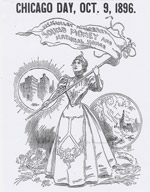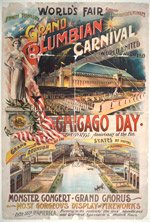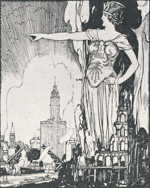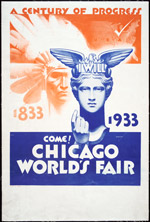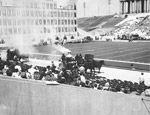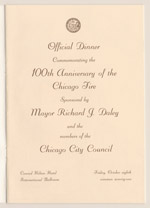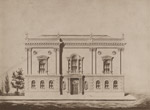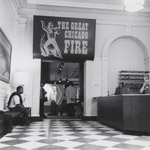Commemorating the Catastrophe
Therefore the men of Chicago resolved that the twenty-fifth anniversary of her destruction by fire should not pass without such a demonstration as should convince the world that she is very much more alive than ever.
G. W. Steevens, The Land of the Dollar
In the years following the fire, Chicago devoted many public occasions to the memory of the great conflagration, but the lesson taught by almost all ceremonies was the need to look ahead, not back. A proposed monument was started but never finished--mainly because of lack of interest. Although speakers and journalists retold the story of the calamity each October, their main purpose was to marvel at the extent of the recovery and of the city's limitless potential.
As the decades passed, a dwindling few would wistfully recall the pre-fire days when, in their opinion, Chicago was a simpler and more civil community, but they were all but drowned out by the ever-upward booster spirit. For those hundreds of thousands of newcomers who staked their own success and happiness on the city's future, Chicago's earlier years had little personal meaning, especially since virtually all physical evidence of it had been removed, first by the flames and then by the rebuilding.
Almost any act of public remembrance reveals as much or more about the present as it does about the past. The man who reenacted Paul Revere's ride at America's Bicentennial in 1976 galloped past the Bagel Bin and the Minuteman Car Wash, and he made his journey in daylight out of fear of getting run over if he sounded his alarm by night. But purposeful present-mindedness was especially apparent in events organized to commemorate the fire. The twenty-fifth anniversary, for example, was dominated by the presidential election campaign and the debate over the gold standard, which had been so eloquently attacked by William Jennings Bryan at the 1896 Democratic National Convention (held in Chicago) and so aggressively defended by William McKinley and the Republican press.
For that same anniversary the Chicago Business-Men's Association organized a "sound money" parade. British journalist G.W. Steevens observed to his astonishment that it took more than five hours for what he estimated as 100,000 marchers to pass by him and the other 750,000 onlookers. The rabidly anti-Bryan Tribune was pleased to note that there were fewer than 13,000 marchers in the free silver procession staged by the Democrats that evening. (Steevens counted 30,000, and he commented that they had more spring in their step than the gold advocates.) A political cartoonist dressed up Bryan as Mrs. O'Leary, replacing the cow with the Democrats' mule, which was about to kick over a flaming lantern labeled "Anarchy."
The grandest commemoration of the fire was the World's Columbian Exposition of 1893. Although the official reason to hold this greatest of America's world's fairs was to celebrate the quadricentennial of Columbus's historic voyage, like the Inter-State Exposition of two decades earlier it was intended to demonstrate Chicago's astonishing resurrection and continuing promise. Partly to boost business, as well to celebrate certain holidays and honor different constituencies, the fair planners organized a number of special theme days. The most successful by far was October 9, designated as Chicago Day, which culminated with a gala "night pageant" of floats, music, and fireworks. The spirit of the occasion, and of Chicago, was represented in posters and statuary by a comely and determined young woman whose classical garb includes a breastplate inscribed with the city's motto, "I Will." She wears a crown in which is perched a phoenix.
The fiftieth anniversary commemoration, in 1921, was elaborately orchestrated by the Chicago Association of Commerce. The Association designated October 3-9 as the dates for what they called the "Chicago Fire Semi-Centennial Observance." The publicity for the observance hardly mentioned the actual fire at all except as the moment the rebuilding began. "It is desirable," the Association explained, "that the coming anniversary shall be the starting point of a great civic awakening and definite program for the building of the 'Chicago of Tomorrow'--that the next fifty years--even greater in accomplishments than the past--shall round out a century of unparalleled achievement."
The Association implored all civic, commercial, educational, religious, social, and neighborhood organizations to participate. To this end it engaged Chicagoans in a multitude of activities. These included an opening ceremony attended by the city's leaders and an audience of 5,000; an "Americanization Demonstration" in Grant Park at which 6,500 people "re-dedicated" Chicago and watched as 648 "newly made citizens" received their naturalization papers; special exercises, sermons, and speeches in schools, churches, theaters, and clubs; a semi-centennial song performed at observance exercises; an illustrated book on Chicago; and a festival play "vividly dramatized by a cast of 2,500 people, and augmented by a chorus of 500 voices with an orchestra of 100 pieces" staged in a 15,000-seat stadium in Grant Park.
On Chicago Day of 1933 at the Century of Progress, Chicago's second world's fair, Mayor Edward J. Kelly looked up from his prepared remarks and called for the exposition to be re-opened the following summer, which it subsequently was. By the time of Kelly's speech, however, Chicago's shining prospects, let alone the fire, were far from the public mind. The country was suffering from the Depression, and for the previous five years--and for the first time in Chicago's history--the city's population had been declining. So the fire anniversary was devoted to drumming up badly needed business both at the fair and beyond. Retail merchants downtown tried to entice shoppers with a series of bargain promotions, starting with "Home Needs" day (moving on to "Women's Apparel Day," "Children's Day," "State Street Day," and "Men's Day"), a parade of floats bearing attractive models, and a huge party and cake. "Breaking the frosting from the inside," a feature story promised, "will be a pretty girl chosen as the spirit of State Street."
To be sure, there was some mention of the fire in these commemorations. Mrs. Henry E. Mason, whose father-in-law had been mayor at the time of the conflagration, was hostess of a special Chicago Day reception at the 1933 fair. A year later, three firemen who hadfought the conflagration, all now in their eighties or nineties, posed for the papers alongside Mayor Kelly. In related festivities, the Century of Progress reprised the spectacular Chicago Day ceremonies of the Columbian Exposition with a pageant and fireworks show, titled "The Burning of Chicago." A description explained how the destruction of the city would be recapitulated against the night sky: "Gradually growing into the scene will be the buildings of downtown Chicago, then considered architectural wonders; the water front with boats at dock, the spires of churches, and a downtown street scene. A moment later all will be consumed by leaping, crackling flames. As the fire dies and visitors troop from the grounds they will see the Chicago that rose from the holocaust--the Chicago that endured to sponsor the world's greatest exposition."
In 1971 Chicago marked the centennial with a number of events that had less of the specifically commercial character of some of the previous major anniversaries. As had been the practice at least since the semi-centennial, the city used the anniversary to emphasize the need for fire safety. The main public commemoration was the October 9 Fire Prevention Parade on State Street, which consisted largely of a procession of fire-fighting equipment. In the parade were not only two horse-drawn engines from the Chicago Fire Department, but also an 1867 engine sent to Chicago in 1871 from the northern Illinois town of Harvard. It sprayed water on an appreciative crowd of spectators estimated at fifty thousand. That night the city sponsored still another bravura piece of pyrotechnics, a forty-five-minute fireworks display climaxing with Mrs. O'Leary's cow upsetting the lantern and sending the 1871 skyline up in flames.
In his speech the evening before at the official fire centennial banquet, Mayor Richard J. Daley followed what was by then a long tradition when he interpreted the conflagration in terms of the key issues of the current day. Though Chicagoans who endured this terrible trial "realized that the city in 1871 had many imperfections," he contended, they knew that "this is where they belonged." Daley continued, "This was the source of their greatness. This is the heritage they gave us. Their dream for the future was a better home, a better neighborhood, a better city." Among the guests were representatives of countries and of American cities that had been so generous in sending aid to Chicago a century earlier.
As the city's repository of civic memory, the Chicago History Museum (formerly called the Chicago Historical Society) has devoted itself to keeping the past alive. It was dealt a serious blow when its new building and virtually all of its pre-fire collections fell to the flames in 1871. Most of what little did escape was lost in the fire of 1874. The Society, like the city, rose again from the ashes, and among its wealth of holdings is an enormous collection of fire materials. Well into the twentieth century, its officers and staff solicited eyewitness narratives, which it has published in different editions. Exhibition space has always prominently featured the fire, and the museum has loaned fire-related objects to displays and events organized by the city, other institutions, and Chicago businesses. At the fiftieth anniversary, the Society hosted an afternoon reception and tea at which those who had experienced the fire first-hand traded stories. The next evening there was a formal celebration for four hundred guests, many of them descendants of Old Settlers, at which several female members dressed in fashions from the fire era. On hand were the son, grandson, and great-grandson of Mayor Mason. Twenty-five years later, the galleries including two new fire exhibits, one including contemporary pictorial materials and mementos, the other devoted to newspapers and periodicals that covered the disaster.
The fire centennial exhibition of 1971 was one of the most ambitious in the Society's history to that time. In addition to a larger number of fire artifacts and documents than had ever been put on view previously, it included a "Little Theater" showing an eight-minute slide show on the fire, mannequins in period costume, photographs of prominent Chicagoans who experienced the fire, and pictures of the city in 1871 and 1971. Other highlights were a preview of a local television station documentary on the disaster (one of several produced at the time) and an outdoor concert. The program performed by conductor Dieter Kober and the Chicago Chamber Orchestra--Handel's Royal Fireworks Music, Haydn's Fire Symphony, and Ives's "Fireman's Parade on Main Street"--was very similar to what they would play at the centennial dinner hosted by Mayor Daley.
Like all the other fire commemorations, the fire exhibits that the Chicago History Museum mounted have often revealed as much about the current day as they have about 1871. When for a fire commemoration in the late 1980s CHM tried, as it had done before, to rent a cow to accompany a woman dressed as Mrs. O'Leary, the cow's owner explained that the protests of animal rights activists had persuaded him to give up this line of business. Different exhibits have drawn from the same body of resources, but, while they have unmistakable similarities, they have varied a good deal in just what they have included and how contents have been presented. These variations reveal, among other things, changes in emphasis and the development of new means of presentation. By the end of the 1970s, the Chicago History Museum, reflecting its curators' desire to make more room for other areas of Chicago history, had condensed the fire exhibit into a few choice objects and produced an eleven-and-a-half-minute multi-media show that dramatically presented over 160 images of items from the collections while unfolding the story of the conflagration in a stirring narrative, complete with a background of fire songs. The most recent Chicago history galleries, entitled "Chicago: Crossroads of America," integrate the fire with six other challenging events in a section called "City in Crisis."
This online exhibition employs the Internet to assemble a richer and deeper selection than can be mounted in the actual galleries of the Chicago History Museum or viewed and read in a single or even multiple visits. It also takes advantage of the dynamic potential of multimedia digital resources in making them available. At the same time it attempts to make viewers aware of the extent to which what we remember is always dependent on how we remember it.
